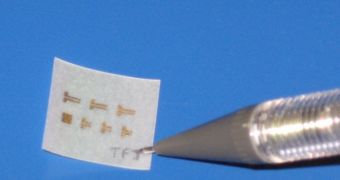State of the art field effect transistors found a new rival recently in the form of thin film transistors having as substrate and interstrate a single layer of paper. This is the first time when FETs find their way onto paper. The new field effect transistor with paper interstrate layer was developed by Elvira Fortunato and her colleagues of the Centro de Ingestigacao de Materiais at Faculdade de Ciencias e Tecnologia, Universidade Nova de Lisboa, Portugal.
The technology, currently used to build field effect transistors, uses as substrates glass or crystalline silicon. Biopolymers on the other hand, offer the possibility of creating electronics at even lower costs. And because cellulose is the most commonly known biopolymer on Earth, it was suggested on multiple occasions by different studies as a potential material to create the physical support for electronic devices.
The newly invented device however, not only creates the substrate for the FET transistor but it also works as interstrate. Paper, being mostly cellulose, has good electric insulator and dielectric properties as well so, to create the new device, the team from Cenimat/I3N, led by Elvira Fortunato and Rodrigo Martins, used a single sheet of common paper as dielectric layer on which semiconductor oxides were printing on both sides.
"[It] is a two in one," says Elvira Fortunato regarding the fact that the paper sheet works as substrate and interstrate at the same time. Better still, Fortunato says that the electrical characteristics of the new transistor are closely similar to those of oxide thin film transistors and way over those of TFTs made with amorphous silicon substrates.
The results of the study suggest that in the near future disposable electronic devices, paper displays, smart labels, smart packaging, bio-applications, RFID tags and many more could become reality. The results will be published in the IEEE Electron Device Letters in September.

 14 DAY TRIAL //
14 DAY TRIAL //